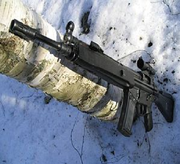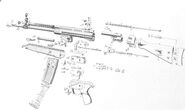- For the civilian variant, see Heckler & Koch HK43.
The HK33 is a 5.56mm assault rifle developed in the 1960s by West German armament manufacturer Heckler & Koch GmbH (HK), primarily for export. Capitalizing on the success of the G3 design, the company developed a family of small arms (all using the G3 operating principle and basic design concept) consisting of four types of firearms: the first type, chambered in 7.62×51mm NATO, second – using the 7.62×39mm round, third – the intermediate 5.56×45mm caliber and the fourth type – chambered for the 9×19mm Parabellum pistol cartridge.
The HK33 series of rifles were adopted by the Brazilian Air Force (Força Aérea Brasileira, FAB), the armed forces of Thailand and Malaysia where they were produced under a license agreement. The Chilean armed forces used the HK33 and then replaced it with the FN SCAR. The rifle was also license-built in France by MAS and in Turkey by MKEK. The HK33 is no longer marketed by Heckler & Koch.
History[]
During the 1960s, the German government developed four weapon designs, one chambered into 7.62×51mm, the second model, the 7.62×39mm and the 5.56×45mm NATO, as well as the 9×19mm Parabellum.
The HK33 was primarily exported to Brazil, Thailand and Malaysia. The US Navy SEALs made a direct copy, known as the T223, the T223 was used in extremely limited numbers. The HK33 is no longer produced by Heckler & Koch, but in France by MAS and Turkey by MKEK.
Design Details[]
The HK33 is a select-fire delayed blowback-operated weapon. It employs a roller-locked two-piece bolt consisting of a bolt head and bolt carrier. After firing, two cylindrical rollers in the bolt head are cammed inward by inclined surfaces of the barrel extension and locking piece within the bolt carrier under rearward pressure on the bolt head, delaying the bolt’s movement relative to the bolt carrier which is withdrawing at four times the velocity of the bolt head. After the rollers compress into the bolt head clearing the locking recesses of the barrel extension, both parts continue moving back together, opening the breech and operating the extraction and feeding cycle. The breech is opened under very high pressure, to increase extraction reliability the bore chamber is fluted.
The bolt also contains a spring extractor, an anti-bounce device (that prevents the bolt from bouncing after impacting the barrel breech) and a buffer. The lever ejector was placed in the trigger housing (actuated by the recoiling bolt).
The HK33 has a hammer-type firing mechanism.
In the standard version, the rifle comes equipped with an ambidextrous trigger group with a selector lever that is simultaneously the weapon’s safety (it has three positions: “S” or “0” – weapon is safe, “E” / “1” – semiautomatic fire, “F” / “25” – continuous fire). The “safe” setting mechanically disables the trigger. The rifle is fed from 25-round steel magazines weighing 250 g or 40-round aluminum magazines (weighing 157 g). 30-round arch magazines were also introduced for use with the rifle.
The weapon is aimed using adjustable iron sights with a rotating rear drum (corrected mechanically for windage and elevation) that contains a notch used for firing at 100 m and three aperture settings for 200, 300 and 400 m. The receiver top cover has notches permitting the attachment of a clamping mount (standard with the HK33, G3, G3SG/1 and MP5) for use with a telescopic sight (usually a Hensoldt 4x24 scope) or a night vision device.
The barrel is equipped with a closed-type slotted flash suppressor that enables the use of rifle grenades and supports a bayonet.
During its production life the rifle received several minor improvements (these modified weapons are sometimes referred to as the HK33E). The fixed stock was strengthened and the synthetic forearm replaced with a handguard that allows a lightweight bipod to be attached and stowed into two recessed grooves at the base. The shoulder pad in rifles fitted with a telescopic stock was changed to a concave type used thus far in the Heckler & Koch MP5 series. Initially the rifle was produced with a 305 mm (1:12 in) twist rate barrel, which was later upgraded to the faster 178 mm (1:7 in) twist rate (used to stabilize new, heavier NATO standard SS109/M855 ammunition).
Included with the rifle are a detachable bipod, bayonet (from the G3), sling, cleaning kit and a magazine loader. Additionally, the HK33 can be used to mount a 40 mm under-barrel HK79 grenade launcher or a blank-firing adaptor.
Variants[]
- HK33 - Original design from 1968.
- HK33A2 - Fixed rigid stock model.
- HK33A3 - Collapsing stock model, also found on the G3 and MP5

HK33A2 with ACOG
- HK33SG/1 - Sharpshooter variant with a scope, hand-picked barrel and cheek riser that retains automatic fire. A telltale sign of a SG/1 from a standard HK33A2 is the addition of a specialized trigger group on the SG/1; fitting a scope and a cheek riser to a normal HK33A2 will not make it a SG/1.
- HK33KA3 - Shortened barrel and folding stock variant, due to size of handguard, it cannot attach a grenade launcher or bayonet.
- HK53 - Compact carbine variant, categorized by H&K as a submachine gun, despite being 5.56mm.
- HK13 - HK21 variant chambered for 5.56mm and 30 round box magazine.
- Type 11 - Thai copy of the HK33.
- HK93 - Semiautomatic civilian version of the HK33 imported into the United States between 1975 and 1989.
- C93 - Civilian variant. Made by Century Arms.
- V93 - Civilian variant. Made by Vector Arms.
- T223 - American copy of HK33 made by Harrington & Richardson. Saw limited use by the Navy SEALs during the Vietnam War.
